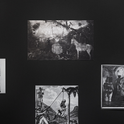One effect of the explosion of demand in the art market has been the rise of a figure distinct from gallerists, dealers, auction houses, curators and museum directors. This is the art adviser, whose role is to mediate between the other players.
Art advisers are not new. Charles I used them when he acquired his collection in the 17th century. But in today's era of rapid growth, UHNWIs (ultra-high net worth individuals) are forming a new class of monarchs and dukes, all keen to establish their own "courts," for which an art collection is the sine qua non. Wealth does not confer an instant knowledge of art history or supply a familiarity with the thousands of names on the globalised market. It certainly does not mean—in a world where waiting lists for the best artists are longer than those for NHS operations in the 1980s—that you can buy what you want. Collectors are unlikely to have the time or patience to trawl the six or seven big annual fairs, let alone smaller ones. As a consequence, almost every new collector has an art adviser.
They come in many sizes, from multi-million dollar deal-makers to young art history graduates—often from Sotheby's MA courses—keen to earn a living from their favourite pastime, looking at art. I met one of these, Sima Familant, at a party for a New York opening. She had brought along two thirtysomething Wall Street financiers. One was already collecting works (he had ten); the other, judging by the way he was grooving on the dancefloor with a young female artist, was likely to start soon. "With people who are new to contemporary art and don't understand the market, it is difficult for them to make good choices as they don't understand why one thing is $10,000 and something else is $20,000," Familant told me.
I met Mark Fletcher, a young but established adviser, in his flat on the 66th floor of a new skyscraper on the edge of Central park. His real estate was an embodiment of the art boom: he'd gone up in the world since I had last met him in a small uptown flat on only the sixth floor. His living room walls were themselves a work of art—a vast technicolour mural by the trendy young Brazilian artist who calls himself Assume Vivid Astro Focus—and, on one of them, was hung a large screenprint of a handgun by Warhol. Fletcher wouldn't tell me whom he advised, or what he had been advising them to buy. He did confirm that art advisers typically take a fee of 10 per cent of the value of the work purchased (a fee taken from the buyer, not the seller). Judging by the walls of his flat, Fletcher had been encouraging his clients not to flinch at hundred-thousand—if not million—dollar price tags.
Advisers are becoming the most powerful force in the art market, although they are naturally too discreet to admit it. The rise in prices for modern works has outstripped what public institutions can afford. Museums rely on gifts and loans from the collectors—and what collectors own is decided by their advisers. According to this logic, that means that art advisers are writing art history today.
As well as being arbiters of taste, advisers are a vital component of the manipulations of the art market. Without them, collectors wouldn't know what to buy, nor would gallerists know whom to sell to. The first rule of every gallerist is to sell to collectors who will keep the works they acquire and loan or donate them to museums. What they want to avoid at all costs is the speculative collector who buys only to sell the work at auction. Too many works on the block can lead to a crash in value for an artist; but even a high price at auction for a young artist can create pressures to push up prices for his work to unsustainable levels. In today's market, with a flood of new entrants, the gallerist needs an intermediary to guarantee the good faith of the collector.
But art advisers are having their cake and eating it, because they are also essential to the auction market. The rocketing of art prices is driven by auction houses—often a work's auction value can be four times what it sells for in a gallery. An art adviser is useful for collectors who want to acquire works at auction—discreetly. Few of them want people to know what they are buying and for how much. This is not simply a way of protecting their privacy as buyers. It's a fundamental way of manipulating the market. A collector who owns several works by one artist has a vested interest in seeing the value of works by that artist rise, so he or she may send in a proxy to "bid up" works by that artist when they come on the market. Alternatively, if you are selling a work, and you know there is one wealthy potential buyer, you may wish to send someone in to bid up that buyer.
Thus the art adviser has become a vital structural support in the pyramid scheme that is the art market—with the same vested interest in seeing the prices of art go up as collectors, auctioneers and gallerists. "We don't know what's going to happen. We've never been at this level before," one adviser told me in a moment of indiscretion. "It's like global warming. We've let out so much CO2 we don't know what the future's going to look like."











